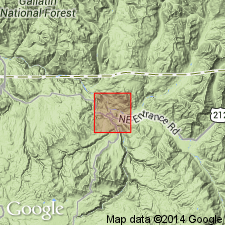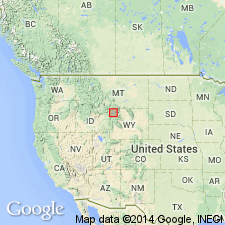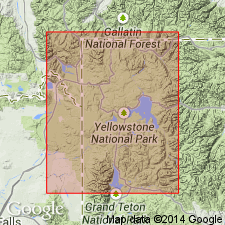
- Usage in publication:
-
- Junction Butte basalt
- Modifications:
-
- First used
- Dominant lithology:
-
- Basalt
- AAPG geologic province:
-
- Yellowstone province
Summary:
First published. Neither intent to name nor type locality designated. Is a columnar basalt 200 ft thick. Forms a vertical cliff on north side of Junction Butte. The butte is in the interconfluence of Yellowstone and Lamar Rivers, northern Yellowstone National Park, WY in Yellowstone province. Is post-trachyte in age [post-Lost Creek trachyte?]. Age not clearly stated. Probably Miocene and Pliocene. Geologic map.
Source: GNU records (USGS DDS-6; Denver GNULEX).

- Usage in publication:
-
- Junction Butte Basalt*
- Modifications:
-
- Named
- Dominant lithology:
-
- Basalt
- AAPG geologic province:
-
- Yellowstone province
Summary:
Pg. B4 (fig. 2), B6 (table 1), B9-B10. Junction Butte Basalt. Exposed in northern Yellowstone National Park, in valley of Yellowstone River and on adjacent uplands from near Deep Creek to Blacktail Deer Creek and Mount Everts. Ranges in thickness from a few meters to about 100 m. Top of Junction Butte is commonly an erosional stripped surface, but locally underlies Huckleberry Ridge Tuff, Mount Jackson Rhyolite, or Lava Creek Tuff (all new). Unconformably overlies Eocene Absaroka Volcanic Supergroup and Paleozoic and Precambrian rocks. Base of Junction Butte commonly includes a few meters of gravel, sand, and silt.
. Gravel, which includes cobbles of Absaroka Volcanic Supergroup, sand, and silt commonly lie just above base
At its type, the Junction Butte consists of three or four flows; total thickness 90 m. Unconformably overlies volcanic rocks of Absaroka Volcanic Supergroup; unconformably underlies Wapiti Lake flow of Mount Jackson Rhyolite and Lava Creek Tuff. Forms spectacular roadside cliff just north of Tower Creek. Consists of a single 30 +/-m thick flow called the Overhanging Cliff flow. Characterized by well-developed two-tiered columnar jointing. Basalt described as black, aphanitic, and containing sparse plagioclase phenocrysts.
[Age is Pliocene.] Has not been dated isotopically but probably is only slightly older than 2-m.y.-old Huckleberry Ridge Tuff (new). In Tower Creek-Grand Canyon area flows have stable reverse remanent magnetic polarities, suggesting an age of less than 2.4 m.y (citing Allan Cox, 1969, Science, v. 163, no. 3864, fig. 4). Is part of the first volcanic cycle of the Quaternary Yellowstone plateau. Report includes stratigraphic table, cross section.
Type locality: west side of Grand Canyon of Yellowstone River opposite mouth of Deep Creek (Yellowstone province). Named from prominent butte between Yellowstone and Lamar Rivers, Yellowstone National Park, Park Co., WY.
Source: Publication; US geologic names lexicon (USGS Bull. 1520, p. 158); GNU records (USGS DDS-6; Denver GNULEX).

- Usage in publication:
-
- Junction Butte Basalt*
- Modifications:
-
- Geochronologic dating
- AAPG geologic province:
-
- Yellowstone province
Summary:
One basalt flow included in the Junction Butte has a K-Ar age of 2.15 Ma and a reversed magnetic polarity. Another flow in the Junction Butte has a K-Ar age of 2.01 Ma and a normal magnetic polarity.
Source: GNU records (USGS DDS-6; Denver GNULEX).
For more information, please contact Nancy Stamm, Geologic Names Committee Secretary.
Asterisk (*) indicates published by U.S. Geological Survey authors.
"No current usage" (†) implies that a name has been abandoned or has fallen into disuse. Former usage and, if known, replacement name given in parentheses ( ).
Slash (/) indicates name conflicts with nomenclatural guidelines (CSN, 1933; ACSN, 1961, 1970; NACSN, 1983, 2005, 2021). May be explained within brackets ([ ]).

